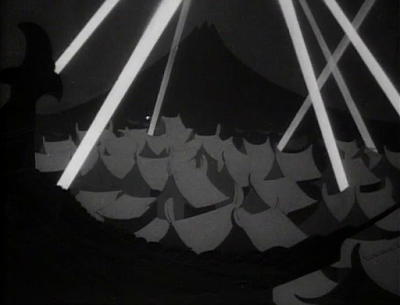One of them is the one-shot Looney Tune Hop and Go, released February 6, 1943. There are some pretty good visual touches in it, but the story (credited to Tubby Millar) stars three weak characters. There’s a dopey kangaroo (who doesn’t have an Australian accent), a rabbit (who has a Scottish accent for some reason) and another rabbit with no personality who barely speaks.
Somehow, Millar wants us to connect with these characters and to a plot about who is really the “champeen” hopper. But does anyone really care? Maybe he thought the early ‘40s love of heckling cartoon characters could somehow carry the film.
On top of that, McCabe seems to have been stuck shoehorning patriotic war stuff into his shorts. In McCabe’s The Ductators, it works well because the characters are clear-cut Axis bad guys. In this one, the ending just seems obligatory. And the best Millar could come up with a name for the kangaroo was "Claude Hopper"?
McCabe has future UPAer Dave Hilberman as his uncredited layout man, and the two try to be creative. The opening is shot at the kangaroo’s visual perspective with the scene hopping up and down. There are attempts at perspective animation. And there’s great use of light and shadow after the kangaroo is catapulted into the night atmosphere by the rabbits.

Claude lights a match to see where he is.


Suddenly, the sound of anti-aircraft fire. Claude twirls around, with his body alternating in shadow, or partly lit.



Now we see the anti-aircraft fire.



Cut to a long shot of Claude flying through the search lights.

There’s an explosion and a crate put in the kangaroo’s pouch by the rabbits jostles out.



As Claude falls, he realises what the crate contains and tosses it away. Claude hit the earth and hops away. The crate hits the earth. Nothing hops away.






Dissolve to Claude, telling us that we now know who the “champeen” is. Cut to a longer shot. Claude has destroyed Tokyo. Cue Porky bursting out of the drum.


Interestingly, the background artist (Dick Thomas?) spells it “Tokyo.” McCabe’s next cartoon spelled it “Tokio.” But the less said about that one, the better.
Cal Dalton is handed the rotating animation credit on this one. Izzy Ellis and John Carey are likely artists on this as well.
Pinto Colvig appropriates his Goofy voice for the kangaroo. Mel Blanc plays both rabbits, with one having his standard Scottish accent he gave to Botsworth Twink on the Abbott and Costello radio show.





























